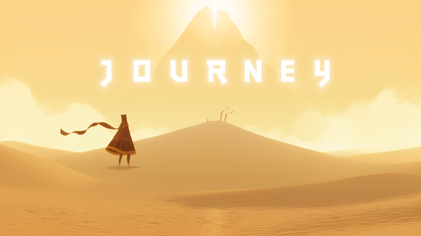For this week’s critical play, I journeyed through the game Journey, an indie adventure game developed by Thatgamecompany, published by Sony Computer Entertainment, and directed by Jenova Chen. The game was originally released on the PlayStation, but was released on PC a few years later, which is the platform I played on this week. Journey is a game suitable for players of all ages, and especially for gamers who want a chill night playing an amazing game 🙂
The theme for this week’s critical play is walking simulators, which are a genre of video games that prioritize exploration, narrative, and atmosphere over traditional gameplay mechanics like combat or puzzle-solving. They typically involve players navigating through detailed environments, uncovering a story through environmental storytelling, audio logs, or dialogue interactions. Journey matches this description perfectly. The game takes you on a journey through the simple act of walking, weaving together themes of isolation, fellowship, and discovery.
The first thing that you experience when you click “Start” on the main menu is the beautiful soundtrack and a cutscene that places you in a vast desert. Your only controls are moving the mouse to move the camera and the “WASD” keys to move the character. The first action you take is to walk up a sand dune towards banners in the distance which reveals how vast the desert and the journey in front of you are. Immediately from the beginning, even though the only mechanic you can control is simply walking the character, the soundtrack, beautiful visuals, and smooth camera movements make you feel immersed in the game. You take the place of the character, isolated in a vast desert, and the only things pointing you in the right direction are banners in the sand and the ever-present light at the peak of the tallest mountain. The slow pace of walking allows you to soak in the landscapes and sounds around you, fostering senses of immersion, curiosity, and discovery.
Even though the majority of the game is spent walking in isolation, the game is still able to foster a sense of fellowship and a desire for companionship. As you make your way to the peak of the mountain, there is a chance of encountering other players, though the only form of communication is through musical chirps. In my playthrough, I encountered another player but soon enough we separated paths, and I was left with a desire to encounter other players as I continued my journey up the mountain.
Following the description of a walking simulator above, Journey is devoid of traditional gameplay mechanics like combat or puzzle-solving. In other games, combat and puzzle-solving adds difficulty and challenge that those games couldn’t do without. In Journey, the difficulty and challenge comes from the environment and the mechanic of walking itself, such as when strong winds slow you down or blow you off course, or when you walk too close to Guardians. The absence of traditional gameplay mechanics like combat or puzzle-solving also allows for the focus to remain on the steps you take and the emotional impact of the journey itself. By limiting the game mechanics to just walking, Journey invites players to immerse themselves fully in the experience, encouraging introspection and reflection on the themes presented.
The mechanism of walking in the game is also a metaphor for the character’s personal journey. As you walk to the top of the mountain, the character undergoes a transformation, literally and metaphorically. By the end, the character is able to fly using the same mechanisms used to walk. The action of walking up the mountain represents the character’s struggle for growth and discovery, never knowing when the journey will end.
At the end of the game, you walk into the light at the peak of the mountain. Mechanically, all you are doing is holding down “W” on your keyboard for what feels like ages. Even though you’re just holding down a key on your keyboard, you’re overwhelmed with emotions that you have experienced as you complete your journey. Emotions of isolation at the beginning, fellowship when you encounter another player, and discovery as landscapes shift and the soundtracks change. Just by pressing four keys on your keyboard and using your mouse, Journey tells a complete story full of emotions through the simple action of walking.




